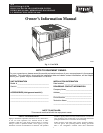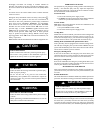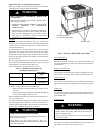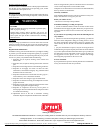
2
thoroughly and follow all warnings or cautions included in
literature and attached to the unit. Consult l ocal building codes,
the current editions of the National Electrical Code (NEC) NFPA
70.
In Canada refer to the current editions of the Canadian electrical
Code CSA C22.1.
Recognize safety information. This is the safety--alert symbol
.
When you see this symbol on the unit and in instructions or
manuals, be alert to the potential for personal injury. Understand
these signal words; DANGER, WARNING, and CAUTION.
These wo rds are used with the safety -- alert symbol. DANGER
identifies the most serious hazards which will result in severe
personal injury or death. WARNING signifies hazards which
could result in personal injury or death. CAUTION is used to
identify unsafe practices which may result in minor personal
injury or product and property damage. NOTE is used to high-
light suggestions which will result in enhanced installation, reli-
ability, or operation.
Note: Installer:Thismanualshouldbeleftwiththeequipmentuser.
FORYOURSAFETY
Failure to follow this caution may result in personal injury.
Do not store or use gasoline or other flammable vapors and
liquids in the vicinity of this or any other appliance.
CAUTION
!
CUT HAZARD
Failureto follow thiswarning could result in personalinjury,
death or property damage.
Do not use this unit if any part has been underwater.
Imme diately call a qualified service technician to inspect the
unit and to replace any part of the control system which has
been underwater.
!
CAUTION
ELECTRICAL SHOCK HAZARD
Failure to follow this warning could result in personalinjury
or death.
Before performing recommended maintenance, be sure the
main power switch to unit is turned off.
!
WARNING
OPERATING YOUR UNIT
Theoperation ofyourpackaged coolingsystemiscontrolledby the
Infinityt User Interface (UI). You may adjust the temperature
manually through the UI or program the UI for automatic control.
See UI manual for detailed instructions.
To start the unit:
1. Turn on the electrical power supply to unit.
2. SetMODEcontroltodesiredmodeand theUIforautomatic
control. See your UI instructions for more details.
To shut off unit:
Note: If the unit is being shut down because of a malfunction, call
your dealer as soon as possible.
1. Set system MODE control to OFF.
2. Turn off the electrical power supply to unit.
Cooling Mode
WiththeUIcontrolsettoCOOL,yourunitwillrunincoolingmode
until the indoor temperature is lowered to the level you have se-
lected.On extremelyhot days,your unitwillrun forlongerperiods
at a time and have shorter “off” periods than on moderate days.
Heating Mode ( if installed with optional electric heat)
Your system may also be equippe d with an electric heating source.
On cold days and nights, place your UI control to HEAT and your
system will automa tically turn on the electricheat inorder to main-
tain the level of comfort you have selected.
Emergency Heating Mode
In the event of UI failure, the emergency heat mode allows your
electricheating sourcetokeepyourhomeor officewarmuntilyour
UI can be serviced. Contact your dealer for more information.
Emergency Cooling Mode
IntheeventofUIfailure,theemergency cooling mode allowsyour
unitto keepyour homeorofficecool untilyour UIcan beserviced.
Contact your dealer for more information.
MAINTENANCE AND SERVICE
This section discusses maintenance that should be performed by
yourdealerandcareyou,astheowner,maywishtohandleforyour
new unit.
Routine Maintenance
Allroutinemaintenanceshould be handled by skilled, experienced
personnel.Yourdealercanhelpyou establisha standardprocedure.
FORYOURSAFETY
Failure to follow this caution may result in personal injury.
Do not store or use gasoline or other flammable vapors and
liquids in the vicinity of this or any other appliance.
CAUTION
!
To assureproperfunctioningoftheunit,flowofcondenserairmust
not be obs tructed from reaching t he unit.Cl earance from the top of
the unit is 48 in. (1219 mm). Clearanceof atleast 36 in. (914 mm)
is required on sides except thepower entry side (42 in. [1067 mm]
clearance) and the duct side (12in. minimum [305 mm] clearance).






